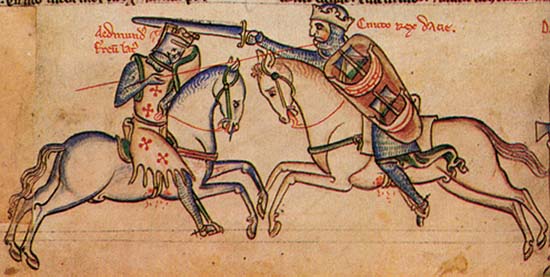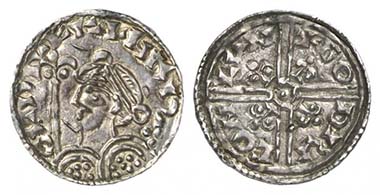by Björn Schöpe
courtesy of Barbara Balz / World Money Fair
The fisherman could not have expected such a catch. What he brought home was nothing less than the body of the king of England. Loyal Danish followers gave him a last resting place in their cemetery in London. A few months earlier, Harold I “Harefoot” had been appropriately buried in Westminster. But his successor Harthacnut had the body of his hated half-brother disinterred and thrown into a sewer. Finally, somebody who meant better for his former king came across Harold’s remains in the River Thames.
In the 8th century AD, Harold’s ancestors, the Vikings, had ravaged the British coast year after year; over time, they began to spend the winter there and eventually established permanent settlements in the east of England, gradually conquering the Anglo-Saxon territories.
Edmond Ironside (l.) fighting against the victorious Cnut (r.). Illustration 14th cent. Source: Wikipedia.
Under Cnut the Great, the crowns of Denmark, Norway and England were united for a short time. During his reign, the Anglo-Saxon subjects continued to pay tribute to Scandinavia to buy themselves off from raids and pillages as they had always done. Despite collecting the so-called Danegeld, the Viking government was exemplary, efficient and just. Cnut decreed that on his death his son Harold should rule England, whereas Harold’s brother Harthacnut should rule Denmark.
When the king died in 1035, his wish was disregarded. Harthacnut took hold of the southern half of England; only the northern part was left to Harold. As a visible expression of their claim to power, both coined money in their respective territories – which travelled to Scandinavia as Danegeld.
Harold I (1035-1040). Penny, London, approx. 1038-1040. Bust to left with fleur-de-lis sceptre. Rv. long voided cross with circle in centre; lis between two pellets in each quarter. Seaby 1165. From Künker auction 176 (2010), 5882.
Discontented with the division of the kingdom, Harold worked towards expanding his rule over the whole of England – as his father had intended for him. While staying in Denmark, Harthacnut learnt what was going on in his realm: Harold had won over a number of nobles for his cause and was elected sole King of England in 1037. Being unable to do anything about that at first, Harthacnut went to Normandy to raise an army. But that was not necessary, after all, for Harold died in March 1040. Three months later, Harthacnut landed in England where he gave free rein to his revenge.
But why is a valiant warrior and energetic king like Harold known to history as “Harefoot”? Actually, he earned his cognomen for being swift as a hare and for his reputation as a hunter!
This article was written for the catalogue of the World Money Fair 2012 whose Guest of Honour is going to be Great Britain. More on the World Money Fair 2012 you can read here.





